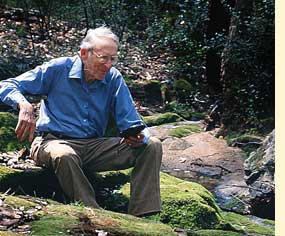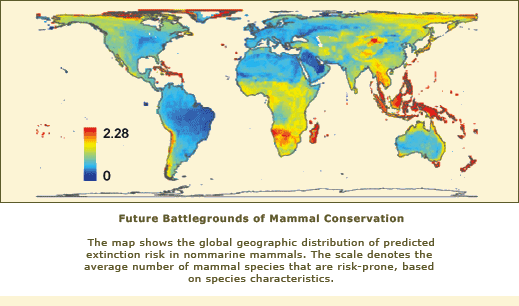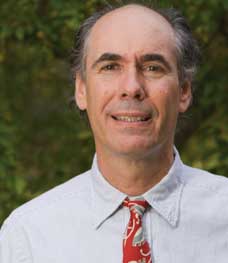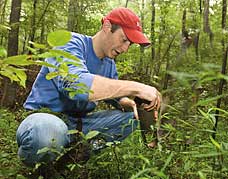Ecology Thrives at UGA
Embracing Odum’s holistic vision
page 1
As he was approaching the end of his life, ecologist Eugene P. Odum feared that the University of Georgia Institute of Ecology, which he founded, would die with him. “We talked about it a few times,” recalls friend and colleague Gary Barrett, who now holds the Odum Chair of Ecology. “And I kept telling him, ‘Gene, the Institute will be here forever. Don’t worry.’”
 Odum died in 2002, and the study of ecology at UGA is thriving like never before. Last year the Institute became the world’s first stand-alone school of ecology. Called the Eugene P. Odum School of Ecology, it is named after the scientist well known for observing, among other things, that “the ecosystem is greater than the sum of its parts.”
Odum died in 2002, and the study of ecology at UGA is thriving like never before. Last year the Institute became the world’s first stand-alone school of ecology. Called the Eugene P. Odum School of Ecology, it is named after the scientist well known for observing, among other things, that “the ecosystem is greater than the sum of its parts.”
“Odum’s legacy, which really has taken root in the modern age as we’re facing more and more environmental change, is a holistic perspective on ecosystems,” says John Gittleman, the Odum School’s first dean. “And one of the hallmarks of the school is an interdisciplinary approach to ecological problems.” By design, its areas of specialty complement each other. Insights gained from ecosystem ecology, infectious disease, and aquatic ecology build on each other and combine with lessons from evolutionary ecology to guide decisions about sustainability.
Thus the Odum School is not several isolated scientists pursuing individual projects, Gittleman says, but an interconnected group of researchers sharing knowledge not only within the school but also across campus and with society. In short, and in the spirit of its namesake, the school is greater than the sum of its parts.
Ecosystem Ecology: Forests of the Future
Odum emphasized that ecosystems, if left undisturbed, reach “a dynamic balance of nature.” Today, however, as ecosystems are being altered by global warming and the spread of invasive species such as Japanese stilt grass, balances seem to be shifting.
“The ecosystems of tomorrow will look different from the ecosystems of today,” says Mark Bradford, ecosystem ecologist at the Odum School. “The question is ‘how are they going to change?’”
At test plots in Massachusetts, Bradford used heating cables buried underground to test the effects of global warming on soil. He found that at higher temperatures the soil-borne bacteria become more active, thereby depleting the soil of carbon necessary for fertility and drought resistance. Bradford also found that the enhanced bacterial activity does eventually slow down and return to normal, but it takes a few years. It’s like a runner who can only sprint for so long, he says.
Closer to home at Whitehall Forest—a 740-acre research area just four miles from the UGA campus—sprawling patches of Japanese stilt grass three-feet deep have established themselves beneath the native oaks and other hardwoods. Preliminary findings from Bradford’s research there show that the invaded underlying soils are wetter and warmer than uninvaded plots, causing effects that are similar to those of climate change.
But there’s hope, he believes. By better understanding how soil bacteria and fungi affect ecosystems, farmers, foresters, and others can manage the land to increase its productivity.
For example, “we’re getting the first experimental evidence that a fungal-dominated system might actually be important in terms of retaining carbon within a system,” says Bradford. “At the same time, we’re also finding that it’s not as simple as bacteria and fungi—that there are hundreds of thousands of below-ground species that we haven’t yet explored.”
Meanwhile, ecosystem ecologist Jackie Mohan made national headlines last year when she found that increased atmospheric carbon-dioxide levels cause poison ivy to produce more of the chemical that causes itchy rashes. Now, Mohan is planning larger-scale experiments to simulate increased atmospheric carbon dioxide, along with soil-warming studies in Georgia, to assess what the plant composition might be like in the forests of the future.
Evolutionary Ecology: From Grave to Cradle

By understanding the past, says John Gittleman, ecologists might be better able to predict the future. Toward that end, he and an international team of researchers have compiled a vast evolutionary “supertree” that combines molecular data with the fossil record to catalog the relationships between the planet’s more than 4,500 species of mammals. The supertree is the most complete species-level tree ever created, Gittleman says. After it was published in Nature last year, he and his colleagues found themselves cited in more than 100 newspapers and broadcast outlets worldwide.
Because the supertree gives scientists detailed information about the relationships between species, researchers can study relatives of species at risk of extinction to investigate whether they face similar threats. Using the supertree in combination with a previous study that created detailed global maps of 20,000 vertebrate species’ distributions, scientists can home in on regions of the planet that are most threatened today or likely to be threatened in the future.
Gittleman is also interested in what he calls “the flip side of extinction.” Using the supertree and data on species distribution, he is studying the role that ecological factors—such as climate and species-specific factors (reproductive rate and body size, for example)—play in the formation of new species. The ultimate goal is to protect tomorrow’s diversity hotspots as well as today’s.
“Evolutionary ecology is focused not only on the characteristics that drive species to their graves,” says Gittleman, “but also on where the cradles of new populations are and how new life is generated.”
Infectious Diseases: Recognizing Patterns
Interest in ecology blossomed after the 1953 publication of Odum’s landmark textbook Fundamentals of Ecology, but the field has grown in ways that would’ve been hard to predict then. Infectious diseases, for example, are scarcely mentioned in Fundamentals, but constitute a major area of research at the new Odum School.
After seeing a little-known parasite wipe out a colony of monarch butterflies in a colleague’s lab more than a decade ago, infectious disease researcher Sonia Altizer began sampling various monarch populations. Among those that migrate, the parasite was hardly a problem. But for populations that live in warm climates and don’t need to migrate, the parasite exacts a tremendous toll.
“I almost fell out of my chair when I started looking at samples under the microscope,” Altizer recalls. “In some of the areas where monarchs breed year-round and don’t migrate, every single butterfly was covered with parasites.” In fact, her research suggests that any disruption of monarch migrations—through degradation of their Mexican wintering grounds, say, or a northward shift of the populations in response to global warming—could make disease outbreaks more common.
 |





